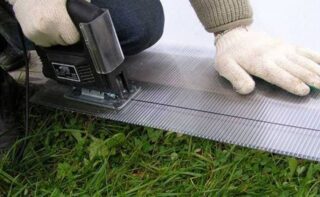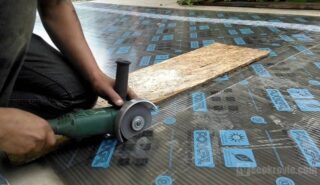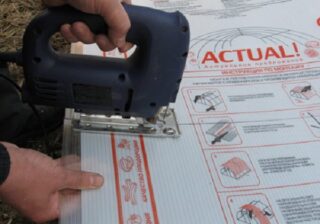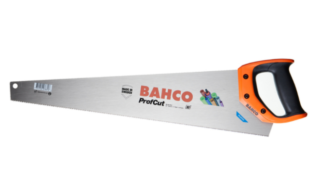One of the reasons for the popularity of polycarbonate is due to the fact that it can be easily processed and adjusted to the size of self-made buildings. Cutting polycarbonate is a responsible operation, since if the technology is incorrect, it is easy to spoil the panel, incurring material costs. For each case and type of material, select the appropriate tool and follow the cutting order.
Dangers when cutting

At home, cellular polycarbonate is most often used. Sheets consist of flat panels, interconnected by partitions. There can be from one to five air chambers. Themselves polycarbonate planes and partitions have a thickness of no more than 1 mm and when cutting it is easy to make breaks and get torn edges.
Monolithic sheets are produced by casting and there are no voids inside the panels. The material is strong and tough, and melts when heated. Incorrect cutting will burn carbon compounds and turn brown.
In connection with these features, they approach the choice of technology responsibly. Compliance with simple rules allows you to carefully cut polycarbonate at home.
Required tools
At industrial enterprises for the manufacture of small architectural forms - greenhouses, pavilions, canopies, etc. - laser and milling machines controlled by programs are used for cutting. The modes of operation ensure accuracy up to 1 mm to customer drawings, and the edges do not require additional processing.
A suitable tool for cutting polycarbonate at home is in the arsenal of any owner of a private property.
The sections are closed with perforated or sealing tape, which hides small irregularities. It is important to respect the dimensions of the parts and not spoil the appearance of the panel with creases, dents, and random through holes.
You can cut polycarbonate to size:
- a clerical knife;
- angle grinder (grinder);
- hacksaws for plastic or metal;
- electric jigsaw.
Honeycomb panels up to 2 mm thick are sometimes cut with reinforced sewing or metal scissors. Monolithic polycarbonate thicker than 3 mm will crumble when processed with such a tool.
For marking, use a tape measure, a long ruler, an even bar, a marker.
Preparation of the workplace and tools

Cellular polycarbonate is easy to crush and break along the inner partitions. Sharp objects can easily punch through holes in the panel.
Before starting the manipulation, the workplace should be prepared. The entire sheet must rest on the base, so its table cannot be less than 2150 mm. The length of a standard sheet is 6 or 12 meters; there should be no dangerous objects in this area.
For styling and cutting use:
- workbenches or tables of a suitable size;
- covered with fiberboard or OSB floors under awnings;
- cleaned and leveled soil.
For convenience and avoidance of damage, approaches to the workplace are freed from debris and foreign objects that can disturb the balance of the master or cause him to fall. The space is cleaned from all sides, since the standard sheet width of 210 cm does not allow for a cross-cut, located on one edge.
In the manufacture of non-standard products, first make the layout of the parts cut to scale on a sheet of paper. This will help avoid a lot of waste. When drawing, do not forget that inexpensive panels are most often protected by a UV coating on one side and cannot be installed with a protective layer inside the structure.
If you need to lean on a sheet during work, you should put a wide sheet of chipboard or a planed board on which you can walk for support.
Markup
For marking, the sheet is laid with a protective film facing up. All lines are drawn directly on the film, which is removed after installing the part on the mounting frame.
Contours can be drawn using a dark marker. For convenience, use plastering rules of long length or other even objects. For small parts, you need a building corner.
Knife

Knives can cut cellular polycarbonate with a thickness of 4 and 6 mm. The tool is suitable for straight lines, but when cutting curly parts it is better to refuse it, so the work will take a lot of time and will require great accuracy. The tool can slide along the ribs, ruining the part.
Do not cut with a knife honeycomb material with more than two chambers and monolithic canvases.
The blade must be carefully honed, and new replaceable blades are inserted into the office or construction tool.
The step-by-step algorithm looks like this:
- Prepare an even base.
- Lay down the sheet and carry out the markup.
- A metal rail, usually a steel ruler, is pressed against the cutting line, which will serve as guides. Wooden parts are not used, as the blade will cut into them and get stuck. An assistant is involved to fix the long guides.
- Cut from the far edge towards you.
- Try again, leading with a knife along the left groove, if at one time it was not possible to separate the part from the sheet.
When cutting polycarbonate, the technique of cutting drywall is not used. If the sheet is not cut through, it will not be possible to break it.
You can use a knife when cutting the side of an arched greenhouse. For this, the panel is laid on the assembled extreme arch and, using it as a template, excess material is removed.
Angle grinder

The grinder is used to cut polycarbonate in a straight line or with minimal bending - the tool is not used for curly parts.
For work, craftsmen use cutting wheels for concrete, aluminum or metal. There is no consensus on which circle is better. An important condition is that the circle should be as thin as possible.
Try different circles and choose the one that gives the best cut quality without melting the edges or heating the panel to a high temperature.
A grinder with a high number of revolutions is not suitable, if there is an adjustment, then set the minimum rotation speed.
Sequence of work:
- Prepare the workplace.
- A wooden beam of sufficient thickness is laid under the sheet so that the circle does not reach the base and rotates freely.
- Cover the cut with a 24 mm thick wooden board and press.
- They turn on the grinder, give them a working speed.
- The material is cut.
Cut along the lintels along the internal void channel, without capturing the stiffening ribs.
The particles of plastic trapped in the honeycomb are removed with a vacuum cleaner or the cavities are blown out with a compressor. It is undesirable to use water for flushing, so before installation you will have to wait for the panel to dry, which takes a long time.
Electric jigsaw

The power tool is ideal for cutting curly parts that are difficult to make with a saw, grinder or knife.
File requirements:
- the teeth should only be small;
- you cannot use a tool with set teeth, they must be located in the same plane.
Some manufacturers facilitate the choice by releasing special files marked "for plastic".
Before starting work, it is advisable to check your skills and the quality of the seam, working with unnecessary pieces of material. Upon obtaining the skills and the correct selection of the tool, they begin cutting the parts.
Process features:
- a wooden support of the required thickness is installed under the panel so that the saw blade moves freely without resting on the base;
- it is advisable to use a new replaceable tool;
- before starting cutting, a notch is made at the end with a knife so that the beginning is even;
- they begin to cut off the polycarbonate after a set of operating revolutions by the electric motor;
- do not allow a gap between the sole of the jigsaw and the sheet, since vibrations lead to damage to polycarbonate;
- cut from themselves, moving forward.
To speed up the work, thin material can be cut by laying it in several layers.
Hacksaw for plastic
Polycarbonate is placed on the edge of the desktop so that the base does not interfere with the movement of the canvas. The top is pressed with a wooden or metal strip. To prevent cracking, the web is positioned at a minimum angle.
The secret of success depends on how firmly the plate is fixed between the base and the clamp - the slightest vibrations lead to cracking along the cut line and jamming of the tool.
Hacksaw for metal
It is impossible to cut parts longer than 40-50 cm in length with a standard hacksaw due to the design features.
For work, replaceable blades are used, installed in holder handles. The direction of the teeth should be forward, away from the handle.
The cutting speed will be low, but the cut quality is good.
It is important to securely fasten the workpiece between the stand and the clamp. They work smoothly, without jerking, which can cause scoring.
The angle between the part and the blade should be 30-40 degrees.
Laser and milling machine

If you need to get a large number of curly parts, it is better to contact a professional organization. As a rule, such enterprises have laser cutting machines.
Cutting of monolithic sheets is often carried out on dimensional milling machines with program control.
Even if you have a milling machine at home, it will be difficult to find a replacement tool and operating modes so as not to damage the polycarbonate during the milling process.
General recommendations
It is possible to cut polycarbonate qualitatively and without errors at home, following the recommendations of experienced installers:
- Carefully prepare the place of work, freeing it from unnecessary items and laying a flat base.
- A long ruler and a fresh marker are prepared with which clear visible lines can be drawn.
- The material is laid with the outside facing up.
- Polycarbonate is securely fixed between the lower base and the clamping bar - the slightest vibrations deteriorate the quality of the end face of the part.
- After finishing work with the part, the cavities are blown out with a compressor or the sawdust is removed with a vacuum cleaner.
- Choose the right tool depending on the cut configuration and the type of polycarbonate.
- The formed notches are cut off with a sharp knife - clerical or construction. This will ensure a snug fit of the sealing tape and prevent moisture from entering the cavity.
If the seller or manufacturer does not provide services for cutting polycarbonate, you can cope with the task using a tool at home. Smooth lines are made with a hacksaw, knife, grinder; for a figured cut, a jigsaw is used. It is important to correctly mark the material, do not rush, be careful.









